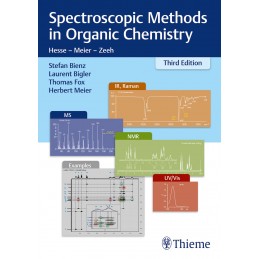- Reduced price

Order to parcel locker

easy pay


 Delivery policy
Delivery policy
Choose Paczkomat Inpost, Orlen Paczka, DHL, DPD or Poczta Polska. Click for more details
 Security policy
Security policy
Pay with a quick bank transfer, payment card or cash on delivery. Click for more details
 Return policy
Return policy
If you are a consumer, you can return the goods within 14 days. Click for more details
Boost your knowledge of modern spectroscopic methods!
This reference work provides you with essential knowledge for the application of modern spectroscopic methods in organic chemistry. All methods are explained based on typical practical examples, theoretical aspects, and applications.
The following spectroscopic methods are explained and examples are given::
The textbook has been a standard reference for decades. As it conveys necessary knowledge for examinations at all universities it is compulsory reading for every organic chemistry student!
Data sheet
1 UV/Vis Spectroscopy
1.1 Theoretical Introduction
1.2 Sample Preparation and Measurement of Spectra
1.3 Chromophores
1.4 Applications of UV/Vis Spectroscopy
1.5 Derivative Spectroscopy
1.6 Chiroptical Methods
2 Infrared and Raman Spectra
2.1 Introduction
2.2 Basic Principles
2.3 Infrared Spectrometer
2.4 Sample Preparation
2.5 Infrared Spectrum
2.6 Characteristic Absorptions: An Overview
2.7 Infrared Absorptions of Single Bonds with Hydrogen
2.8 Infrared Absorptions of Triple Bonds and Cumulated Double Bonds
2.9 Infrared Absorptions of Double Bonds C=O, C=N, N=N, and N=O
2.10 Infrared Absorption of Aromatic Compounds
2.11 Infrared Absorption in the Fingerprint Range
2.12 Examples of Infrared Spectra
2.13 Information Technology Assisted Spectroscopy
2.14 Quantitative Infrared Spectroscopy
2.15 Raman Spectroscopy
3 Nuclear Magnetic Resonance Spectroscopy
3.1 Physical Principles
3.2 NMR Spectra and Molecular Structure
3.3 1H NMR Spectroscopy
3.4 13C NMR Spectroscopy
3.5 Combination of 1H and 13C NMR Spectroscopy
3.6 NMR of other Nuclei
4 Mass Spectrometry
4.1 Introduction
4.2 General Aspects of Mass Spectrometry
4.3 Instrumental Aspects
4.4 Interpretation of Spectra and Structural Elucidation
4.5 Sample Preparation
4.6 Artifacts
4.7 Tables to the Mass Spectrometry
5 Handling of Spectra and Analytical Data: Practical Examples
5.1 Introduction
5.2 Characterization of Compounds
5.3 Structure Elucidation of Allegedly Known Compounds and of Products Arising from Syntheses
5.4 Structure Elucidation of COmpletely Unknown Compounds
